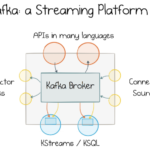
Event-Driven Serverless Microservices; Web Application Engineering
August 4, 2023
Introduction to Kafka as a Streaming Platform
September 10, 2023Prompt engineering,
refers to the skill of crafting effective and clear instructions when interacting with AI models.
1. Retrieval of Information:
When seeking information, your prompt should clearly define what you’re looking for and provide context.
• Example Prompt:
“Could you please provide an overview of the main postulates proposed by Albert Einstein in his theory of general relativity? I’m particularly interested in understanding how these postulates revolutionized our understanding of gravity.”
In this prompt, you’ve not only specified the request for an overview of the main postulates but also added context by mentioning the revolutionary impact of these postulates.
• Example Prompt:
“I’m writing a report on noble gases. Can you furnish me with a list of the noble gases found in the periodic table along with their atomic numbers?”
In this example, you’ve mentioned the purpose of your request (“writing a report”) and the specific details you need (“list of noble gases along with atomic numbers”).
2. Text Generation:
When generating text, providing a clear topic and any specific requirements can help the AI generate relevant content.
• Example Prompt:
“I’m preparing a presentation on classical conditioning and operant conditioning. Could you craft a detailed comparison between these two concepts, focusing on their underlying principles and real-world applications?”
Here, you’ve mentioned the purpose (“preparing a presentation”), the topic (“classical conditioning and operant conditioning”), and additional guidance (“underlying principles and real-world applications”).
• Example Prompt:
“As part of a biology project, I need to explain cellular respiration. Can you compose a paragraph that outlines the stages of cellular respiration, including glycolysis, the citric acid cycle, and oxidative phosphorylation?”
In this case, you’ve specified the context (“biology project”), the topic (“cellular respiration”), and the specific components to be covered.
3. Programming Help:
For coding assistance, clarity about the problem and programming language is crucial.
• Example Prompt:
“I’m learning Java and currently working on recursion. Could you walk me through the implementation of a factorial function using recursion? A code snippet and explanation would be extremely helpful.”
Here, you’ve indicated your learning stage (“learning Java”), the topic (“recursion”), and the specific assistance you’re seeking (“factorial function”).
• Example Prompt:
“In my C++ class, we’re exploring variable manipulation. I’d like to see an example of code that swaps the values of two variables without using a temporary variable. Could you provide both the code and an explanation?”
This prompt outlines your class context (“C++ class”), the topic (“variable manipulation”), and the request for both code and explanation.
4. Creative Writing:
When requesting creative content, set the scene, mood, or theme to guide the AI’s imagination.
• Example Prompt:
“I’m working on a science fiction story set in the future. Can you craft a paragraph describing a bustling cityscape with flying cars weaving through skyscrapers and holographic advertisements lighting up the night?”
This prompt establishes the genre (“science fiction”), the setting (“future bustling cityscape”), and the key visual elements.
• Example Prompt:
“For a short story assignment, I’d like to create a dialogue scene. Can you write a conversation between two characters meeting for the first time in a cozy cafe during a rainstorm?”
Here, you’ve specified the assignment (“short story”), the context (“cozy cafe during a rainstorm”), and the type of content (“dialogue scene”).
5. Conversational Interaction:
When engaging in a conversation, you can guide the conversation’s direction using a system message.
• Example Prompt:
“System, let’s chat about the ethical considerations of artificial intelligence in healthcare.”
AI Response: “Certainly! Ethical considerations in the context of artificial intelligence in healthcare are vital…”
• Example Prompt:
“System, I’m interested in learning about the history of space exploration.”
AI Response: “Of course! The history of space exploration is a fascinating journey through human ingenuity and scientific progress…”
In both cases, your system message sets the topic and tone for the conversation, helping the AI understand your intention.
6. Clarifying Complex Concepts:
When asking for explanations, break down the concept and context to ensure clarity.
• Example Prompt:
“I’m studying thermodynamics and have come across the term ‘entropy.’ Could you explain what entropy means in this context and how it relates to the transfer of energy? Some practical examples would be appreciated.”
This prompt specifies your context (“studying thermodynamics”), the concept (“entropy”), and the request for explanations and examples.
• Example Prompt:
“In my psychology course, we’re discussing empathy. Can you elaborate on the concept of empathy, its various forms, and its significance in enhancing interpersonal relationships?”
Here, you’ve stated your course context (“psychology course”), the concept (“empathy”), and the focus areas (“forms” and “significance in enhancing interpersonal relationships”).
7. Generating Poetry:
For creative writing like poetry, convey the mood, theme, or emotions you want the poem to convey.
• Example Prompt:
“I’m writing a reflective poem about nature. Can you compose a short poem that captures the tranquility of a peaceful forest illuminated by golden sunlight?”
In this prompt, you’ve defined the theme (“nature”), mood (“tranquility”), and visual imagery (“peaceful forest illuminated by golden sunlight”).
• Example Prompt:
“As part of a creative writing assignment, I’m exploring the theme of new beginnings. Could you create a poem that conveys the excitement and anticipation of embarking on a fresh adventure?”
Here, you’ve specified the assignment context (“creative writing assignment”) and the theme (“new beginnings”), along with the emotions (“excitement and anticipation”).
8. Coding Challenges:
When presenting coding challenges, provide clear problem statements and expectations.
• Example Prompt:
“For a coding exercise, I need to reverse a string in Python. Can you solve this challenge by implementing a function that accomplishes this task?”
This prompt defines the context (“coding exercise”), the task (“reverse a string”), and the programming language (“Python”).
• Example Prompt:
“I’m practicing algorithms in JavaScript and encountered a problem. Could you write a function that finds the maximum element in an array of numbers? An explanation of the approach would be very helpful.”
Here, you’ve specified the learning focus (“practicing algorithms”), the problem (“find the maximum element in an array of numbers”), and the request for both code and explanation.
9. Detailed Responses:
When seeking in-depth explanations, set the context and specify the depth of analysis.
• Example Prompt:
“I’m researching the decline of bee populations. Could you provide a detailed analysis of the factors contributing to this decline and the potential ecological consequences? References to recent studies would be appreciated.”
This prompt establishes the research context (“decline of bee populations”), the scope (“factors contributing” and “ecological consequences”), and additional guidance (“references to recent studies”).
• Example Prompt:
“As part of a project on artificial intelligence, I’m looking for an extensive overview of its history. Please include key milestones, breakthroughs, and notable figures in the field.”
Here, you’ve indicated the project context (“artificial intelligence project”), the scope (“history,” “key milestones,” “breakthroughs,” and “notable figures”), and the desired level of coverage (“extensive overview”).
Summarization
For summarizing content, define the document, length, and focus of the summary.
• Example Prompt:
“Summarize this recent article on machine learning advancements in 2023. Highlight the breakthroughs in natural language processing and computer vision and provide a concise overview within 200 words.”
This prompt designates the source (“a recent article on machine learning advancements”), the focus (“breakthroughs in natural language processing and computer vision”), and the length constraint (“within 200 words”).
• Example Prompt:
“I’m reviewing a research paper on climate change effects on marine ecosystems. Could you condense the paper into a brief summary of around 100 words, emphasizing the implications for coastal regions?”
Here, you’ve indicated the review context (“reviewing a research paper”), the focus (“climate change effects on marine ecosystems”), the length constraint (“around 100 words”), and the emphasis (“implications for coastal regions”).
These detailed examples demonstrate how to craft prompts with specific context, guidance, and expectations to effectively communicate your needs to AI models and receive tailored and relevant responses.
Views: 63


